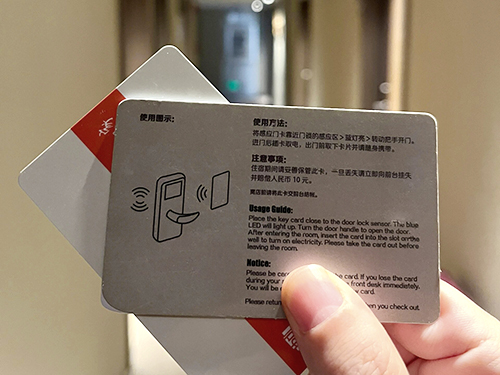Unlocking Hotel Convenience: A Complete Guide to Hotel Cards and Their Functions
- Oct 11 , 2025
- By: Guangzhou Zhanfeng Smart Card Technology Co.,Ltd.
- Follow Us
In the daily operation and customer service of hotels, various functional cards play a vital role. These cards not only facilitate interactions between hotels and guests but also ensure the smooth running of daily services. The most common types of hotel cards include hotel membership cards, hotel room cards, hotel IC cards, and hotel ID cards. While they may seem similar at first glance, each type has distinct definitions and practical uses. Let’s break down their specific roles and characteristics in the hotel environment.
1. Hotel Room Cards: Your "Electronic Key" for Accommodation
As the most frequently used card by guests during their stay, the core function of a hotel room card revolves around room access. After completing the check-in process at the hotel front desk, guests receive their room card—essentially an "exclusive electronic key" for the duration of their stay. To enter the room, guests simply hold the card near the sensor area on the door; this triggers the door lock’s unlocking mechanism, allowing easy entry.

Most traditional hotel room cards on the market feature a magnetic stripe on the back. This stripe stores key information such as the room number and the card’s valid period, ensuring accuracy and convenience when used. Unlike other hotel cards, the room card’s purpose is highly focused: it only grants access to the assigned room, making it a straightforward yet essential tool for guests.
2. Hotel Membership Cards: Symbols of Identity and Exclusive Benefits
Hotel membership cards are more than just plastic cards—they serve as identity markers and carriers of exclusive privileges. Their design logic is similar to membership cards used in shopping malls, gyms, or restaurants: they help hotels identify members and provide tailored services. For example, members might enjoy perks like room upgrades, late check-out, or discounts on food and beverages—all of which are linked to their membership status.
Moreover, membership cards from chain hotel brands often work across other business formats under the same group. A guest with a membership card from a hotel chain might use it to access discounts at the chain’s affiliated restaurants or spas, expanding its utility beyond just hotel stays. This type of identity-verification card is also widely used in non-hotel settings: schools (as student IDs), clubs (for entry permission), companies (as employee cards), and public institutions. In all these cases, the core purpose remains the same: to verify identity and grant access to exclusive services or spaces.
3. Hotel IC Cards and ID Cards: Multi-Functional and Secure Tools
Compared to room cards and membership cards, hotel IC (Integrated Circuit) cards and ID (Identification) cards offer more comprehensive functions, higher security, and greater convenience. They don’t just unlock doors—they also integrate services like point accumulation and cashless payments. For instance, when a guest dines at the hotel’s restaurant, uses the gym, or buys snacks from the gift shop, they can pay directly with their IC or ID card. After the transaction, the system automatically adds reward points to the card, which can later be redeemed for benefits like free stays or souvenirs.
The working principle of IC cards, in particular, relies on radio frequency (RF) induction technology, which ensures stability and security. Here’s how it works: The hotel’s dedicated RF card reader continuously emits electromagnetic waves at a fixed frequency. Inside the IC card, there is an LC series resonant circuit—its natural frequency matches the frequency emitted by the reader exactly. When the IC card enters the reader’s induction range, the LC resonant circuit vibrates (resonates) under the stimulation of the electromagnetic waves. This vibration causes the capacitor in the circuit to accumulate electric charge.
At the other end of the capacitor, there is a one-way electronic pump. This pump transfers the charge from the first capacitor to a second storage capacitor. When the voltage of the charge accumulated in the storage capacitor reaches 2V, it acts as a temporary power source, supplying voltage to other circuits inside the IC card. This power allows the card to either send data (such as member information or transaction records) to the reader or receive instructions from the reader (like updating points or authorizing door access). This advanced technology not only makes IC cards secure but also ensures smooth interaction between the card and the hotel’s systems.In summary, each type of hotel card is designed to meet specific needs: room cards for access, membership cards for exclusive benefits, and IC/ID cards for multi-functional convenience. Together, they form a system that enhances the guest experience while streamlining hotel operations—proving that even small plastic cards can make a big difference in travel comfort.

 English
English Russian
Russian French
French Spanish
Spanish Portuguese
Portuguese Italian
Italian Arabic
Arabic German
German